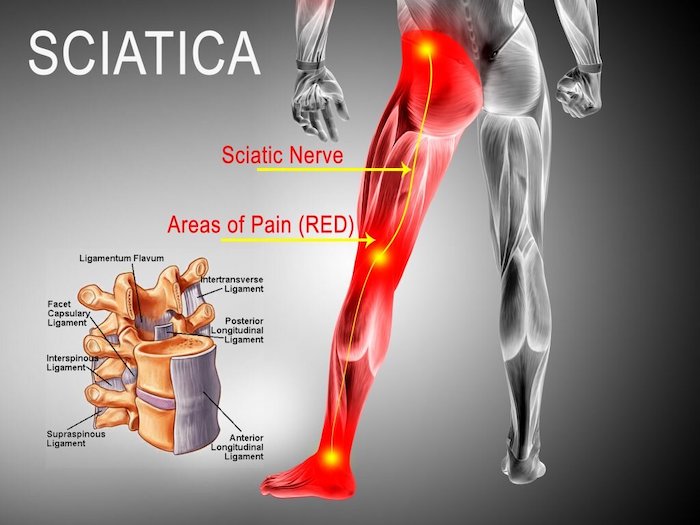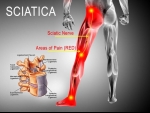
The duration of sciatica typically depends on the type and severity of the underlying problem. While sciatica usually resolves within a few weeks, certain medical conditions can cause your symptoms to last up to two years.
Read on to learn about the common causes of sciatica, when your symptoms may continue to persist, and common treatments and tips to help prevent your back and leg pain from recurring or flaring.
When Acute Sciatica May Become Chronic
Common conditions that may cause sciatica include a problem in your lower back that irritates or inflames a sciatic nerve root, such as:
- Lumbar herniated disc
- Lumbar spinal stenosis
- Lumbar degenerative disc disease
- Spondylolisthesis
- Muscle spasm and/or inflammation in your lower back and/or pelvic muscles
If your lower back problem is recent, you will experience acute sciatica, which may flare intermittently or remain constant for up to 4 to 6 weeks, after which, it typically subsides on its own.
If left untreated or if the underlying cause is severe, sciatica may become chronic and persistent, lasting for two months or more. An estimated 20% to 30% of people may continue to have sciatica for 1 to 2 years.
Treating Sciatica at Home
Sciatica occurs differently for everyone. A number of nerve roots may be affected in the sciatica, each causing pain and/or numbness in a different part of your thigh, leg, and/or foot. The response to a specific treatment may also vary between different individuals with the same diagnosis of sciatica. Finding the right treatment is usually a process of trial and error.
Try a combination of these treatments at home for meaningful pain relief from sciatica:
- Ice therapy. For acute sciatica, try placing an ice pack on your rear pelvis. Ice therapy helps numb the pain, almost immediately, by constricting the blood vessels, reducing blood flow, and decreasing inflammation in the lower back.
- Pain-relieving medication. Try topical pain-relieving creams /gels or take over-the-counter oral medications, such as nonsteroidal anti-inflammatory drugs (NSAID). While oral medications build up in the bloodstream and have a whole-body effect, topical medications may act faster due to their localized effect.
- Heat therapy. If you have chronic sciatica, heat therapy may help relieve your symptoms by relaxing tight muscles and improving blood flow. These effects may also help heal your lower back tissues.
- Massage. Gently massaging your lower back can reduce muscle tension, improve blood circulation, and release endorphins (your body’s natural feel-good hormone). Massage can provide temporary but effective pain relief, enhancing the body’s healing abilities.
It is also important to use ergonomically safe and supported postures when you sit, stand, lift, and walk.
Exercising At Home to Relieve Sciatica
A routine exercise program is beneficial in controlling acute sciatica pain as well as in preventing future flare-ups. Exercises can be learned from a physical therapist and continued at home.
Before beginning any exercise program, it is important to consult a licensed health professional to get a correct diagnosis for the cause of your sciatica. Exercises for sciatica from a herniated disc vary widely compared to those aimed at relieving the symptoms caused by spinal stenosis, and each type of exercise may worsen or further irritate your underlying cause if done incorrectly.
Medical Treatment for Sciatica
If your sciatica is recent (acute), your doctor will likely diagnose the cause of your symptoms based on medical history, physical examination, and diagnostic tests. The recommended treatment will typically include some combination of:
- Prescription medications for sciatic pain relief
- Physical therapy and exercise
- Manual manipulation
- Lumbar epidural steroid injections
While rare, for chronic sciatica that does not respond to several weeks of nonsurgical treatment, surgery may be advocated.
Sciatica accompanied by progressive or severe numbness and/or weakness and changes in bowel and/or bladder movements may indicate more serious underlying conditions, such as cauda equina syndrome, which must be treated on an urgent basis.
Caring for sciatica should be considered a part of daily living. While most symptoms resolve in a few weeks without serious complications,1 sciatica may last for months or years if left untreated. It is important to continue with physical activity and keep up with routine exercises and lifestyle modifications to prevent your sciatica from recurring or flaring.
Precision Pain Care and Rehabilitation has two convenient locations in Richmond Hill – Queens and New Hyde Park – Long Island. Call the Richmond Hill office at (718) 215-1888, or (516) 419-4480 for the Long Island office, to arrange an appointment with our Interventional Pain Management Specialist, Dr. Jeffrey Chacko.













